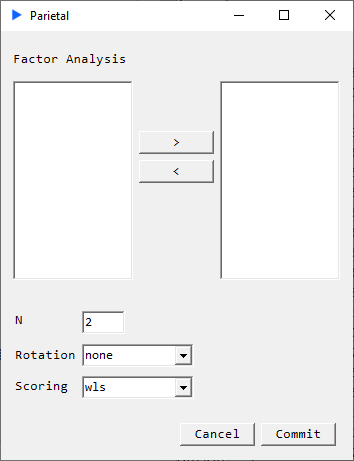Factor Analysis
If we make the assumption that a set of underlying (or latent) variables is responsible for a large part of the dynamics in the target dataset, then we can use a set of techniques that seek to identify and quantify those underlying variables. While many such techniques exist, one such very widely used one is called Factor Analysis.

Rotation Options:
- None
- Equamax
- Orthomax
- Parsimax
- Promax
- Quartimax
- Varimax
Scoring:
- WLS
- Regression
N : Number of Components
Description
The factor analysis model can be described as
$$ Y = \Lambda F + E $$
where
$ \Lambda $ are the factor weights
$ F $ are the factor scores
$ E $ is the error term
Clearly, a reconstructed approximation of the target dataset can be carried out by $ \Lambda * F $. For example, in a single factor model:
$$ \begin{matrix} y_1 = \lambda_{1} f_{1} + \epsilon_{1} \\ y_2 = \lambda_{2} f_{1} + \epsilon_{2} \\ y_3 = \lambda_{3} f_{1} + \epsilon_{3} \end{matrix} $$
Returns
- GoF: Chi-square, p-value, log-likelihood
- Factor Loadings: $ \Lambda\ $ i.e. weights
- Rotation Matrix
- Factor Scores: $ F $
- MLE Variances: